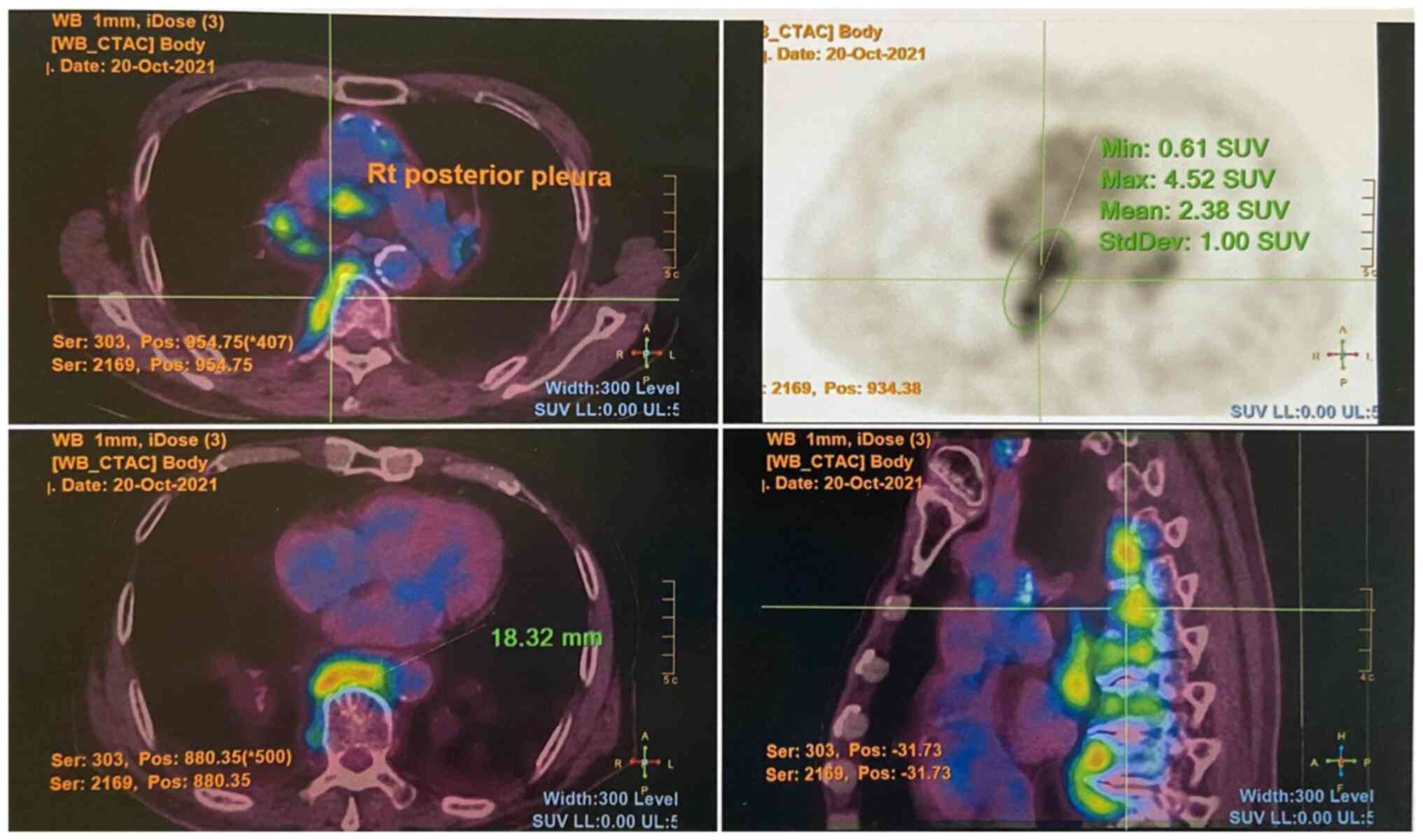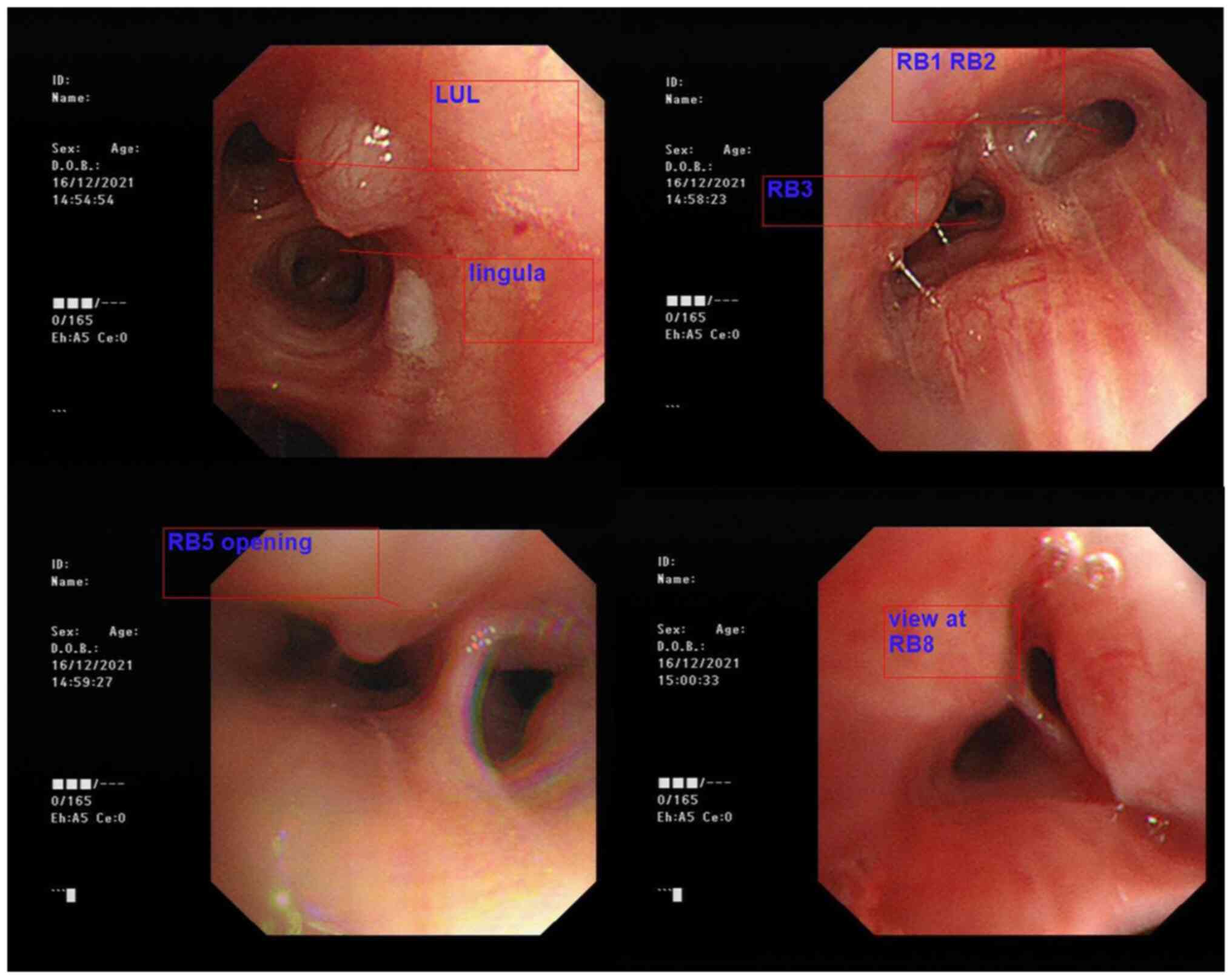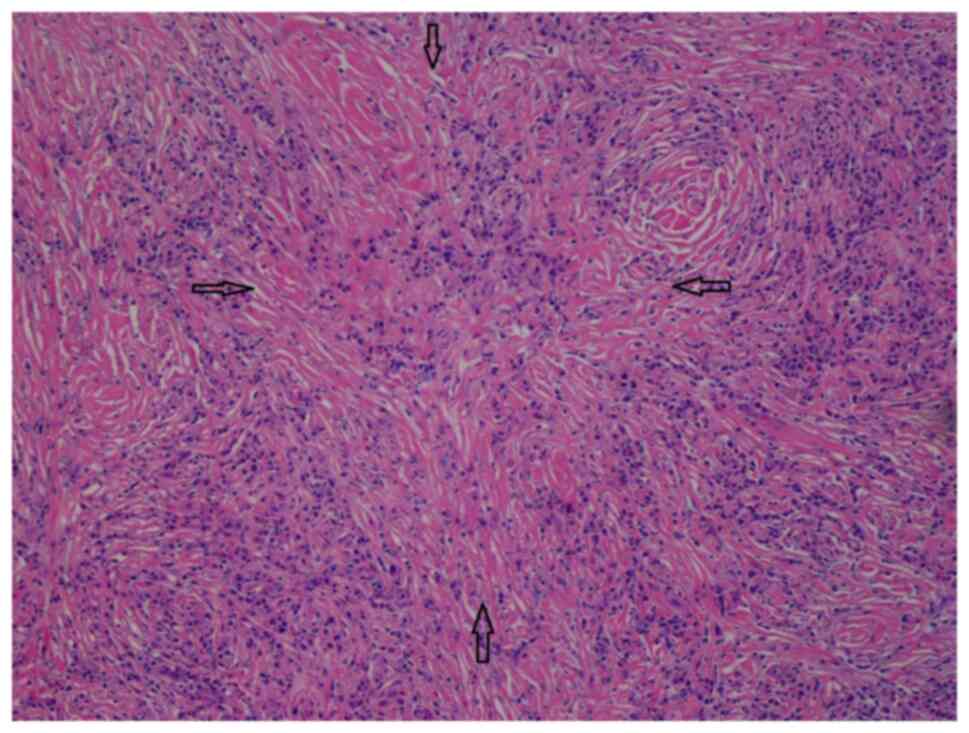IgG4‑related disease with endobronchial nodules: A case report and literature review
- Authors:
- Published online on: March 18, 2025 https://doi.org/10.3892/mi.2025.227
- Article Number: 28
-
Copyright : © Leung et al. This is an open access article distributed under the terms of Creative Commons Attribution License [CC BY 4.0].
Abstract
Introduction
IgG4-related disease (IgG4-RD) is a rare, immune mediated-fibroinflammatory condition that primarily affects patients of middle to advanced age and is more common among males than females (1). IgG4-RD was initially described in 1951 as chronic autoimmune pancreatitis (2,3). In 2003, upon the discovery of extra-pancreatic lesions featuring IgG4-positive plasmacytic infiltration in patients with autoimmune pancreatitis, IgG4-RD was proposed as a novel clinicopathological entity (4). In 2019, IgG4-RD was formally defined by a classification criteria (5). IgG4-RD has been described in virtually every organ and is characterized histologically by the infiltration of immunoglobulin G4 (IgG4)-bearing lymphoplasmacytic cells (6). Respiratory manifestations, or IgG4-related lung disease (IgG4-RLD), encompass various features, such as the presence of solid nodules in the lung parenchyma, the thickening of bronchovascular bundles and interlobular septa, and rounded ground glass opacities (7). The present study describes an uncommon case of IgG4-RLD with endobronchial nodules, as well as systemic involvement.
Case report
An 84-year-old retired electrician with a previous medical history of ischemic heart disease, hypertension and gout was referred to the general medical outpatient clinic of Princess Margaret Hospital, Hong Kong, SAR, China due to a 6-month history of unquantified weight loss. He had no fever, night sweats or any respiratory symptoms. A physical examination of his abdomen, cardiovascular and respiratory systems did not reveal any notable findings, apart from multiple enlarged submandibular lymph nodes. The patient recalled a diagnosis of IgG4-RD more than a decade ago with no treatment offered and claimed there was no marked progression of submandibular swelling over the years.
The levels of tumor markers, including alpha fetal protein (3 µg/l), prostate-specific antigen (<0.03 µg/l) and carcinoembryonic antigen (1.9 µg/l) were withiun normal range. He had an increased eosinophil count (1.9x109/l; reference range, 0.0-0.5x109/l) and an erythrocyte sedimentation rate of 119 mm/h (reference range, <32 mm/h). Autoimmune markers including antinuclear, antineutrophil cytoplasmic, Sjögren syndrome-related antigen A/Ro, Sjögren syndrome-related antigen B/La, double-stranded DNA, ribonucleoprotein and Smith antibodies were all negative. His serum IgG4 count was increased (2,269 mg/dl; reference range, 9-146 mg/dl). A positron emission tomography-computed tomography scan revealed multiple fludeoxyglucose F18 (FDG)-avid enlarged mediastinal, hilar, (Fig. 1) and submandibular lymph nodes, as well as an FDG-avid right parotid gland nodule. An FDG-avid nodular thickening of the right posterior pleura was also noted at the T9/10 level (Fig. 2).
Flexible bronchoscopy incidentally identified diffuse submucosal nodular swelling in both bronchi, featuring a smooth surface continuous with the respiratory tract mucosa (Fig. 3). Multiple endobronchial biopsies of nodules were taken at the right upper lobe anterior bronchus (RB3) and right lower lobe anterior basal bronchus (RB8). An endobronchial ultrasound (EBUS) identified enlarged station 4R and station 10 lymph nodes, with transbronchial needle aspiration (TBNA) performed over the station 4R lymph node. The cytology of the EBUS-TBNA sample only revealed tiny fragments of crushed lymphoid tissue with no granuloma or malignant cells. The histological analysis of multiple endobronchial biopsies revealed benign bronchial mucosa with stromal fibrosis and containing patchy inflammatory infiltration with marked crushing artefact (data not shown).
In view of the diagnostic uncertainty, a left-sided submandibular sialoadenectomy with lymph node excision was performed by the surgeons. A histological examination of the left salivary glandular tissue (hematoxylin and eosin staining; performed by the Histopathology Laboratory of Yan Chai Hospital, Hong Kong, SAR, China; x100 magnification) revealed evidence of chronic sclerosing sialadenitis (Fig. 4). The salivary gland lobules were mostly replaced by storiform fibrosis, reactive lymphoid hyperplasia and lymphoplasmacytic infiltration. Plasma cells were abundant. Obliterative phlebitis was not observed. There was no evidence of malignancy. Immunohistochemistry performed by the Histopathology Laboratory of Yan Chai Hospital revealed a high number of IgG4 plasma cells >100/HPF in the most affected area and the IgG4:IgG plasma cell ratio was >40% (the images for this were not available). All these features were in-keeping with IgG4-RD. Similar features were also observed in the sampled submandibular lymph node.
After the diagnosis of IgG4-RD was made, the patient was treated with prednisolone 10 mg daily (body weight, 63.5 kg) with a gradual tapering regimen. There was a marked reduction in submandibular swelling and his weight remained static. At the latest follow-up, the serum IgG4 level decreased from 2,269 to 314 mg/dl after the 10 weeks of treatment.
Discussion
Various international diagnostic criteria for IgG4-RD are available, including the 2019 American College of Rheumatology/European League Against Rheumatism (ACR/EULAR) Classification Criteria for IgG4-Related Disease, and the 2020 Japan College of Rheumatology's revised comprehensive diagnostic (RCD) criteria for IgG4-RD (5,8). The RCD criteria is the most updated criteria, requiring fulfilment of clinical and radiological, serological and pathological features (Table I). The case described herein fulfils the RCD criteria of definite IgG4-RD.
The diagnostic criteria used in IgG4-RLD is the same as IgG4-RD. Due to its rarity, the exact prevalence of IgG4-RLD is not known; however, studies have reported lung involvement in 2.4 to 27.1% of IgG4-RD cases (9). Patients with IgG4-RLD typically exhibit minimal respiratory symptoms. Its diagnosis is often incidental, discovered during investigations for extrathoracic lesions or as an unexpected finding of abnormal lung shadows (10). Characteristic features of IgG4-RLD on computed tomography scans include hilar lymphadenopathies and the presence of soft tissue masses in the paravertebral region (11). Histopathological findings of IgG4-RD are dense lymphoplasmacytic infiltrate, storiform fibrosis, obliterative phlebitis, and increased numbers of IgG4-positive plasma cells or an increased IgG4:IgG ratio in tissue (6).
Numerous cases of systemic IgG4-RD associated with tracheobronchial edema, or capillary dilatation have been reported, in addition to IgG4-RLD cases featuring isolated tracheobronchial involvement, manifesting as mass-like lesions (7,12,13). IgG4-RLD presents as multiple endobronchial nodules; however, it is extremely rare. To the best of our knowledge, only two previous articles to date have reported IgG4-RLD with multiple endobronchial nodules (7,14). The first case reported by Wang et al (7) involved a 52-year-old male patient who presented with wheezing accompanied by jelly-like sputum. His spirometry results were normal, and a computed tomography scan of the thorax revealed left lower lung infiltrate without obvious bronchial nodules. A bronchoscopy revealed multiple white nodular protuberances in the trachea and bronchus, with mucosal edema and hyperemia. He was diagnosed with IgG4-RLD histologically through standard forceps biopsy and was treated with prednisolone and azathioprine. There was no evidence of involvement of other organs due to IgG4-RD (7). The second case reported by Torii et al (14) involved a 74-year-old female patient with known IgG4-RD affecting the parotid gland and eyelids. She had previously been treated conservatively, with spontaneous resolution of her symptoms. After 3 years, she presented with a recurrence of swelling in the parotid gland and eyelids, which this time, was accompanied by a cough, an obstructive pattern on spirometry, and a computed tomography scan of the thorax revealed extensive multiple nodules in the trachea and bronchi, without any masses or ground-glass nodules in the lung parenchyma. A bronchoscopy revealed multiple nodules with a smooth surface, continuous with the respiratory tract mucosa. A diagnosis was made by an endobronchial cryobiopsy and she was treated with prednisolone (14). Both these aforementioned cases had a resolution of endobronchial nodules demonstrated by repeat bronchoscopies. In contrast to the two cases mentioned above, the patient in the present study had no respiratory symptoms. Spirometry was not performed as a result, and his computed tomography scan of the thorax did not reveal obvious bronchial nodules. Similar to the case reported by Torii et al (14), the patient in the present study exhibited systemic involvement of IgG4-RD with endobronchial nodules that had a smooth surface continuous with the respiratory tract mucosa.
The limitations of the present study include the lack of a follow-up bronchoscopy to prove the resolution of endobronchial nodules following the use of steroids, and no pathological confirmation of IgG4 plasma cells in the endobronchial nodules. However, it was deemed that there were no alternative explanations of the endobronchial nodule.
A histological analysis is vital in diagnosing IgG4-RLD, as the serum IgG4 level may be raised in several other conditions, including multicentric Castleman's disease, repeated infections, autoimmune diseases, cancer, primary immunodeficiencies and systemic vasculitis (15,16). In the case described herein, biopsies of endobronchial nodules had crushing artefacts and were not diagnostic of IgG4-RLD. EBUS-TBNA also failed to reveal specific features. The diagnosis was only made following a histological examination of the left salivary glandular tissue which revealed characteristic IgG4-RD changes. A previous study demonstrated that histological findings from transbronchial lung biopsies supported the diagnosis of IgG4-RLD in 47% of the cases only (17). Apart from the obvious selection of surgical lung biopsy when diagnostic uncertainty is met, transbronchial cryobiopsies have been reported to successfully diagnose IgG4-RLD (12,14).
The treatment for IgG4-RLD is the same as that for IgG4-RD. Glucocorticoids prove to be a potent remedy for IgG4-RD. However, instances of disease resurgence often occur either during or after the dose reduction of glucocorticoids, and these drugs rarely result in sustained periods of remission without further treatment (18). Rituximab, a monoclonal anti-CD20 antibody, was shown to be effective as both induction therapy and treatment of relapses in IgG4-RD in a retrospective nationwide study in France (19). Inebilizumab, a monoclonal anti-CD19 antibody, demonstrated reduction in the risk of IgG4-RD flare up and increased the likelihood of complete remission without flares at 1 year (20). For the patient in the present study, long-term follow-up is necessary to monitor for disease recurrence following the discontinuation of prednisolone. Biological agents should be considered if remission is not achieved.
In conclusion, the present study reported a rare presentation of IgG4-RLD with multiple endobronchial nodules and systemic involvements, found incidentally during flexible bronchoscopy. A histopathological examination of the endobronchial biopsy was inconclusive and diagnosis was made after surgically sampling the left salivary gland and submandibular lymph nodes. This case serves the purpose of reminding physicians to consider IgG4-RLD as a differential diagnosis when endobronchial nodules are observed with or without systemic disease, and appropriate sampling methods should be selected to increase its diagnostic yield.
Acknowledgements
The authors would like to express their appreciation to Dr Ka Choi Yuen, of the Pathology Department of Yan Chai Hospital, Hong Kong for providing and interpreting the histopathology slides.
Funding
Funding: No funding was received
Availability of data and materials
The data generated in the present study may be requested from the corresponding author.
Authors' contributions
CCDL substantially contributed to the acquisition, analysis and interpretation of the data and contributed to the drafting of the manuscript. MYH, YHC and YCY analyzed the patient data and advised on the patient's treatment. CCDL, MYH, YHC and YCY confirm the authenticity of all the raw data, and agree to be accountable for all aspects of the work, so that any questions relating to research integrity or scientific accuracy in any part of the study are appropriately investigated and resolved. All authors have read and approved the final version of the manuscript.
Ethics approval and consent to participate
The patient provided written informed consent to participate in the present study.
Patient consent for publication
The patient provided written informed consent for the publication of any data and/or accompanying images.
Competing interests
The authors declare that they have no competing interests.
References
|
Uchida K, Masamune A, Shimosegawa T and Okazaki K: Prevalence of IgG4-related disease in Japan based on nationwide survey in 2009. Int J Rheumatol. 2012(358371)2012.PubMed/NCBI View Article : Google Scholar | |
|
Sato T, Minegishi K, Okabe N, Osuga F, Sudo K, Sogabe M, Endo S and Tsubochi H: Bronchial obstruction in immunoglobulin G4-related disease. Ann Thorac Surg Short Rep, 2024. | |
|
Sarles H, Sarles JC, Muratore R and Guien C: Chronic inflammatory sclerosis of the pancreas-an autonomous pancreatic disease? Am J Dig Dis. 6:688–698. 1961.PubMed/NCBI View Article : Google Scholar | |
|
Kamisawa T, Funata N, Hayashi Y, Eishi Y, Koike M, Tsuruta K, Okamoto A, Egawa N and Nakajima H: A new clinicopathological entity of IgG4-related autoimmune disease. J Gastroenterol. 38:982–984. 2003.PubMed/NCBI View Article : Google Scholar | |
|
Wallace ZS, Naden RP, Chari S, Choi H, Della-Torre E, Dicaire JF, Hart PA, Inoue D, Kawano M, Khosroshahi A, et al: The 2019 American college of rheumatology/European league against rheumatism classification criteria for IgG4-related disease. Arthritis Rheumatol. 72:7–19. 2020.PubMed/NCBI View Article : Google Scholar | |
|
Stone JH, Khosroshahi A, Deshpande V, Chan JKC, Heathcote JG, Aalberse R, Azumi A, Bloch DB, Brugge WR, Carruthers MN, et al: Recommendations for the nomenclature of IgG4-related disease and its individual organ system manifestations. Arthritis Rheum. 64:3061–3067. 2012.PubMed/NCBI View Article : Google Scholar | |
|
Wang X, Wan J, Zhao L, Da J, Cao B and Zhai Z: IgG4-related disease with tracheobronchial miliary nodules and asthma: A case report and review of the literature. BMC Pulm Med. 19(191)2019.PubMed/NCBI View Article : Google Scholar | |
|
Umehara H, Okazaki K, Kawa S, Takahashi H, Goto H, Matsui S, Ishizaka N, Akamizu T, Sato Y, Kawano M, et al: The 2020 revised comprehensive diagnostic (RCD) criteria for IgG4-RD. Mod Rheumatol. 31:529–533. 2021.PubMed/NCBI View Article : Google Scholar | |
|
Li PH, Ko K, Ho CT, Lau LL, Tsang RK, Cheung T, Leung WK and Lau CS: Immunoglobulin G4-related disease in Hong Kong: Clinical features, treatment practices, and its association with multisystem disease. Hong Kong Med J. 23:446–453. 2017.PubMed/NCBI View Article : Google Scholar | |
|
Matsui S: IgG4-related respiratory disease. Mod Rheumatol. 29:251–256. 2019.PubMed/NCBI View Article : Google Scholar | |
|
Matsui S, Hebisawa A, Sakai F, Yamamoto H, Terasaki Y, Kurihara Y, Waseda Y, Kawamura T, Miyashita T, Inoue H, et al: Immunoglobulin G4-related lung disease: Clinicoradiological and pathological features. Respirology. 18:480–487. 2013.PubMed/NCBI View Article : Google Scholar | |
|
Yamakawa H, Takemura T, Tsumiyama E, Sato S, Akasaka K, Amano M and Matsushima H: IgG4-related bronchial gland inflammation proved by transbronchial cryobiopsy. Am J Respir Crit Care Med. 201:1554–1556. 2020.PubMed/NCBI View Article : Google Scholar | |
|
Shrestha B, Sekiguchi H, Colby TV, Graziano P, Aubry MC, Smyrk TC, Feldman AL, Cornell LD, Ryu JH, Chari ST, et al: Distinctive pulmonary histopathology with increased IgG4-positive plasma cells in patients with autoimmune pancreatitis: report of 6 and 12 cases with similar histopathology. Am J Surg Pathol. 33:1450–1462. 2009.PubMed/NCBI View Article : Google Scholar | |
|
Torii A, Oshima K, Iwakoshi A and Oki M: A case with multiple nodules and mucosal oedema of the trachea and both bronchi induced by IgG4-related disease. BMC Pulm Med. 24(115)2024.PubMed/NCBI View Article : Google Scholar | |
|
Otani K, Inoue D, Fujikura K, Komori T, Abe-Suzuki S, Tajiri T, Itoh T and Zen Y: Idiopathic multicentric Castleman's disease: A clinicopathologic study in comparison with IgG4-related disease. Oncotarget. 9:6691–6706. 2018.PubMed/NCBI View Article : Google Scholar | |
|
Ebbo M, Grados A, Bernit E, Vély F, Boucraut J, Harlé JR, Daniel L and Schleinitz N: Pathologies associated with serum IgG4 elevation. Int J Rheumatol. 2012:1–6. 2012.PubMed/NCBI View Article : Google Scholar | |
|
Otani K, Inoue D, Itoh T and Zen Y: Transbronchial lung biopsy for the diagnosis of IgG4-related lung disease. Histopathology. 73:49–58. 2018.PubMed/NCBI View Article : Google Scholar | |
|
Tanaka Y and Stone JH: Perspectives on current and emerging therapies for immunoglobulin G4-related disease. Mod Rheumatol. 33:229–236. 2023.PubMed/NCBI View Article : Google Scholar | |
|
Ebbo M, Grados A, Samson M, Groh M, Loundou A, Rigolet A, Terrier B, Guillaud C, Carra-Dallière C, Renou F, et al: Long-term efficacy and safety of rituximab in IgG4-related disease: Data from a French nationwide study of thirty-three patients. PLoS One. 12(e0183844)2017.PubMed/NCBI View Article : Google Scholar | |
|
Stone JH, Khosroshahi A, Zhang W, Della Torre E, Okazaki K, Tanaka Y, Löhr JM, Schleinitz N, Dong L, Umehara H, et al: Inebilizumab for treatment of IgG4-related disease. N Engl J Med: Nov 14, 2024 (Epub ahead of print). |













